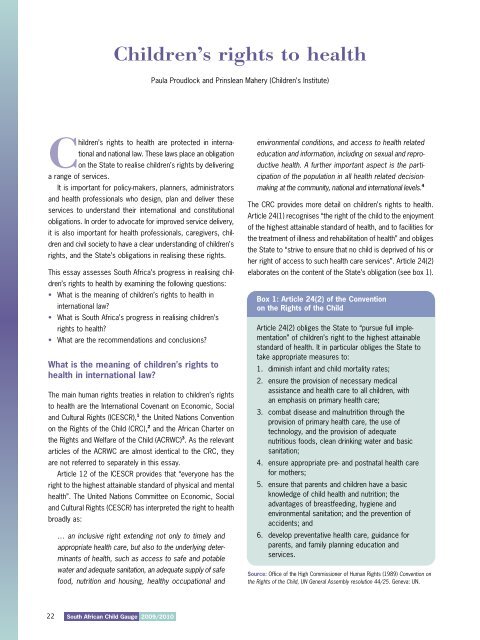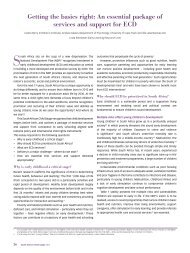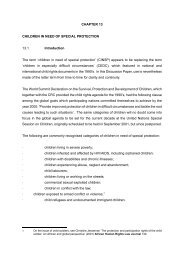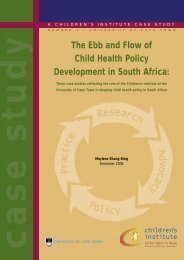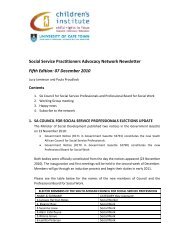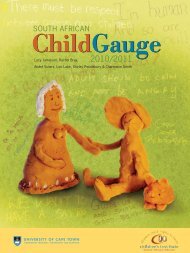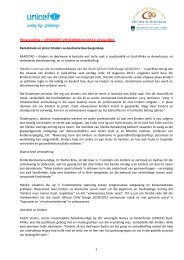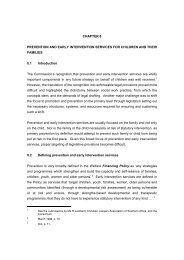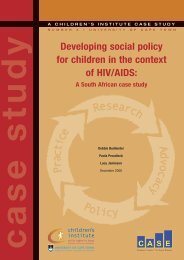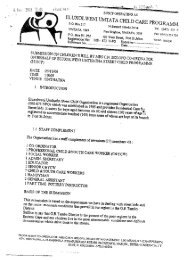South African Child Gauge 2009/2010 - Children's Institute
South African Child Gauge 2009/2010 - Children's Institute
South African Child Gauge 2009/2010 - Children's Institute
You also want an ePaper? Increase the reach of your titles
YUMPU automatically turns print PDFs into web optimized ePapers that Google loves.
<strong>Child</strong>ren’s rights to health<br />
Paula Proudlock and Prinslean Mahery (<strong>Child</strong>ren’s <strong>Institute</strong>)<br />
<strong>Child</strong>ren’s rights to health are protected in international<br />
and national law. These laws place an obligation<br />
on the State to realise children’s rights by delivering<br />
a range of services.<br />
It is important for policy-makers, planners, administrators<br />
and health professionals who design, plan and deliver these<br />
services to understand their international and constitutional<br />
obligations. In order to advocate for improved service delivery,<br />
it is also important for health professionals, caregivers, children<br />
and civil society to have a clear understanding of children’s<br />
rights, and the State’s obligations in realising these rights.<br />
This essay assesses <strong>South</strong> Africa’s progress in realising children’s<br />
rights to health by examining the following questions:<br />
• What is the meaning of children’s rights to health in<br />
international law?<br />
• What is <strong>South</strong> Africa’s progress in realising children’s<br />
rights to health?<br />
• What are the recommendations and conclusions?<br />
What is the meaning of children’s rights to<br />
health in international law?<br />
The main human rights treaties in relation to children’s rights<br />
to health are the International Covenant on Economic, Social<br />
and Cultural Rights (ICESCR), 1 the United Nations Convention<br />
on the Rights of the <strong>Child</strong> (CRC), 2 and the <strong>African</strong> Charter on<br />
the Rights and Welfare of the <strong>Child</strong> (ACRWC) 3 . As the relevant<br />
articles of the ACRWC are almost identical to the CRC, they<br />
are not referred to separately in this essay.<br />
Article 12 of the ICESCR provides that “everyone has the<br />
right to the highest attainable standard of physical and mental<br />
health”. The United Nations Committee on Economic, Social<br />
and Cultural Rights (CESCR) has interpreted the right to health<br />
broadly as:<br />
… an inclusive right extending not only to timely and<br />
appropriate health care, but also to the underlying determinants<br />
of health, such as access to safe and potable<br />
water and adequate sanitation, an adequate supply of safe<br />
food, nutrition and housing, healthy occupational and<br />
environmental conditions, and access to health related<br />
education and information, including on sexual and reproductive<br />
health. A further important aspect is the participation<br />
of the population in all health related decisionmaking<br />
at the community, national and international levels. 4<br />
The CRC provides more detail on children’s rights to health.<br />
Article 24(1) recognises “the right of the child to the enjoyment<br />
of the highest attainable standard of health, and to facilities for<br />
the treatment of illness and rehabilitation of health” and obliges<br />
the State to “strive to ensure that no child is deprived of his or<br />
her right of access to such health care services”. Article 24(2)<br />
elaborates on the content of the State’s obligation (see box 1).<br />
Box 1: Article 24(2) of the Convention<br />
on the Rights of the <strong>Child</strong><br />
Article 24(2) obliges the State to “pursue full implementation”<br />
of children’s right to the highest attainable<br />
standard of health. It in particular obliges the State to<br />
take appropriate measures to:<br />
1. diminish infant and child mortality rates;<br />
2. ensure the provision of necessary medical<br />
assistance and health care to all children, with<br />
an emphasis on primary health care;<br />
3. combat disease and malnutrition through the<br />
provision of primary health care, the use of<br />
technology, and the provision of adequate<br />
nutritious foods, clean drinking water and basic<br />
sanitation;<br />
4. ensure appropriate pre- and postnatal health care<br />
for mothers;<br />
5. ensure that parents and children have a basic<br />
knowledge of child health and nutrition; the<br />
advantages of breastfeeding, hygiene and<br />
environmental sanitation; and the prevention of<br />
accidents; and<br />
6. develop preventative health care, guidance for<br />
parents, and family planning education and<br />
services.<br />
Source: Office of the High Commissioner of Human Rights (1989) Convention on<br />
the Rights of the <strong>Child</strong>, UN General Assembly resolution 44/25. Geneva: UN.<br />
22<br />
<strong>South</strong> <strong>African</strong> <strong>Child</strong> <strong>Gauge</strong> <strong>2009</strong>/<strong>2010</strong>


